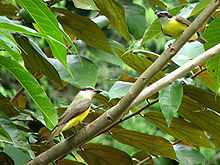Boat-billed Flycatcher
| Boat-billed Flycatcher | |
|---|---|
 | |
| Conservation status | |
| Scientific classification | |
| Kingdom: | Animalia |
| Phylum: | Chordata |
| Class: | Aves |
| Order: | Passeriformes |
| Family: | Tyrannidae |
| Genus: | Megarynchus Thunberg, 1824 |
| Species: | M. pitangua |
| Binomial name | |
| Megarynchus pitangua (Linnaeus, 1766) | |
| Synonyms | |
|
Megarhynchus pitangua (lapsus) | |
The Boat-billed Flycatcher (Megarynchus pitangua) is a passerine bird. It is a large tyrant flycatcher, the only member, monotypic, of the genus Megarynchus.
It breeds in open woodland with some tall trees from Mexico south to Bolivia and Argentina, and through to Trinidad.
The nest, built by the female, is an open saucer of sticks. The typical clutch is two or three whitish eggs heavily blotched with brown. These are incubated mostly by the female for 17–18 days with a further 24 days to fledging.

Adult Boat-billed Flycatchers are one of the largest species of tyrant flycatcher, measuring 23 cm (9.1 in) long and weighing 70 g (2.5 oz).[2] The head is black with a strong white eyestripe and a concealed yellow crown stripe. The upperparts are olive-brown, and the wings and tail are brown with only faint rufous fringes. The underparts are yellow and the throat is white.
The massive black bill, which gives this species its English and generic names, is the best distinction from the similar Great Kiskadee, which also has more rufous tail and wings, and lacks the olive tone to the upperparts. The call is a strident trilled nya, nya, nya.
Boat-billed Flycatchers wait on a concealed perch high in a tree and sally out to catch insects in flight. They will also take invertebrates off the foliage and eat some berries.
References
- ↑ BirdLife International (2012). "Megarynchus pitangua". IUCN Red List of Threatened Species. Version 2013.2. International Union for Conservation of Nature. Retrieved 26 November 2013.
- ↑
- ffrench, Richard (1991). A Guide to the Birds of Trinidad and Tobago (2nd edition ed.). Comstock Publishing. ISBN 0-8014-9792-2.
- Hilty, Steven L (2003). Birds of Venezuela. London: Christopher Helm. ISBN 0-7136-6418-5.
External links
- Boat-billed Flycatcher videos on the Internet Bird Collection
- Boat-billed Flycatcher photo gallery VIREO Photo-High Res
- Photo-High Res; Article moonbeampublishing
